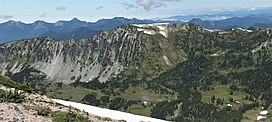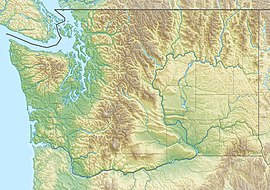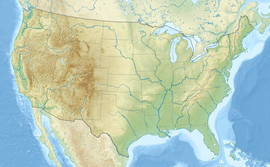Crescent Mountain (Washington)
| Crescent Mountain | |
|---|---|
 South aspect, from Old Desolate | |
| Highest point | |
| Elevation | 6,715 ft (2,047 m)[1] |
| Prominence | 275 ft (84 m)[1] |
| Parent peak | Sluiskin Mountain (7,026 ft)[2][3] |
| Isolation | 0.85 mi (1.37 km)[2] |
| Coordinates | 46°56′53″N 121°45′43″W / 46.948069°N 121.76182°W |
| Geography | |
| Country | United States |
| State | Washington |
| County | Pierce |
| Protected area | Mount Rainier National Park |
| Parent range | Cascades |
| Topo map | USGS Mowich Lake |
| Climbing | |
| Easiest route | scrambling[4] |
Crescent Mountain is a 6,715-ft (2,047 m) ridge-like mountain located in north-central Mount Rainier National Park, in Pierce County of Washington state.[5] It is part of the Cascade Range, and lies 6.6 mi (10.6 km) due north of the summit of Mount Rainier. Sluiskin Mountain is its nearest higher neighbor, 0.85 mi (1.37 km) to the east.[1] Precipitation runoff from Crescent Mountain drains west into tributaries of the Carbon River.
History
[edit]This mountain's descriptive name Crescent derives from its crescent shape as it wraps around Crescent Lake. This feature was named by geologist Bailey Willis in 1883.[6] The name was officially adopted in 1932 by the United States Board on Geographic Names.[5]
Climate
[edit]Crescent Mountainis located in the marine west coast climate zone of western North America.[4] Most weather fronts originating in the Pacific Ocean travel northeast toward the Cascade Mountains. As fronts approach, they are forced upward by the peaks of the Cascade Range (orographic lift), causing them to drop their moisture in the form of rain or snow onto the Cascades. As a result, the west side of the Cascades experiences high precipitation, especially during the winter months in the form of snowfall. Because of maritime influence, snow tends to be wet and heavy, resulting in high avalanche danger. During winter months, weather is usually cloudy, but due to high pressure systems over the Pacific Ocean that intensify during summer months, there is often little or no cloud cover during the summer.[4] The months July through September offer the most favorable weather for viewing or climbing this peak.
See also
[edit]References
[edit]- ^ a b c "Crescent Mountain, Washington". Peakbagger.com.
- ^ a b "Crescent Mountain - 6,715' WA". listsofjohn.com. Retrieved August 3, 2020.
- ^ "Crescent Mountain". Bivouac.com. Retrieved July 13, 2020.
- ^ a b c Beckey, Fred W. Cascade Alpine Guide, Climbing and High Routes. Seattle, WA: Mountaineers Books, 2008.
- ^ a b "Crescent Mountain". Geographic Names Information System. United States Geological Survey, United States Department of the Interior. Retrieved August 3, 2020.
- ^ Mount Rainier National Park Place Names. Gary Fuller Reese (author), 2009.
External links
[edit]- National Park Service web site: Mount Rainier National Park
- Crescent Mountain: weather forecast


